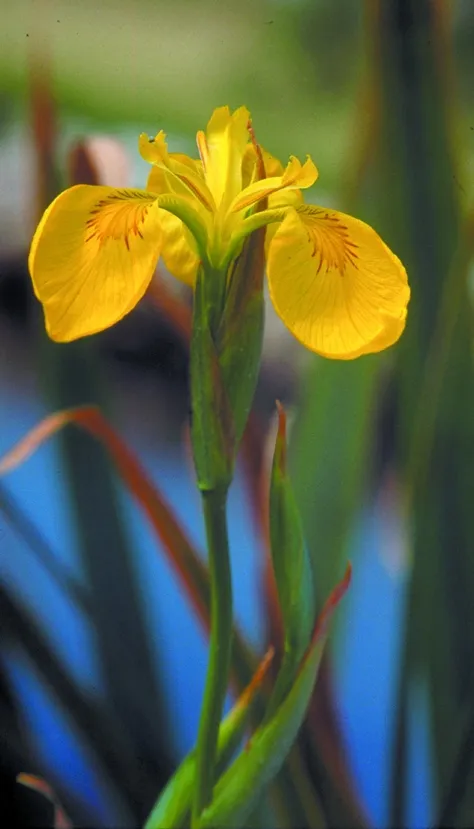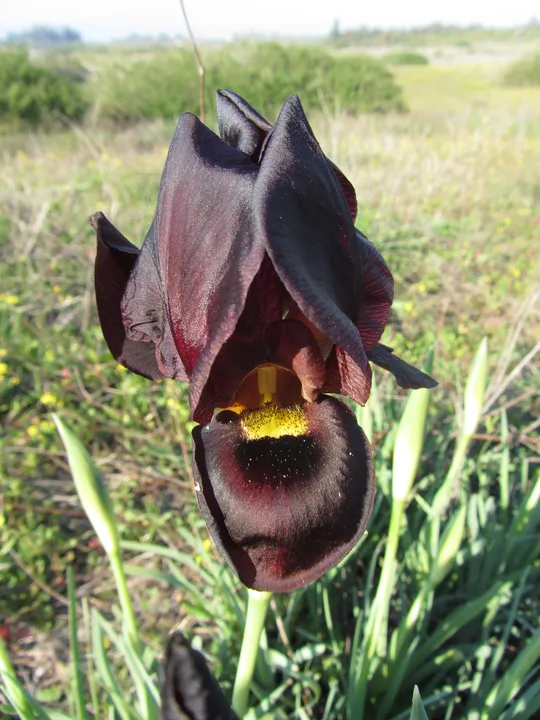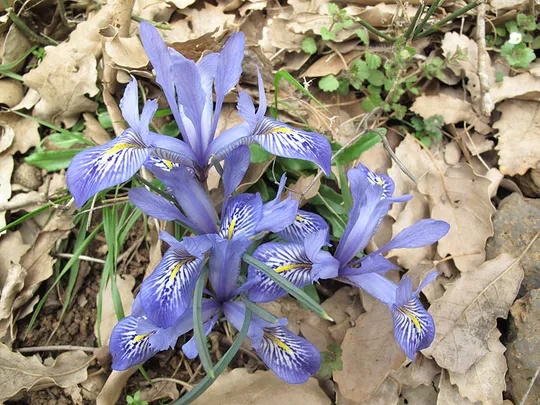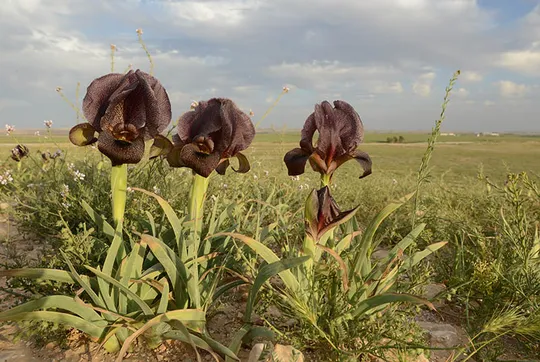Grant-duff's Iris, Jaffa Iris
Iris grant-duffii
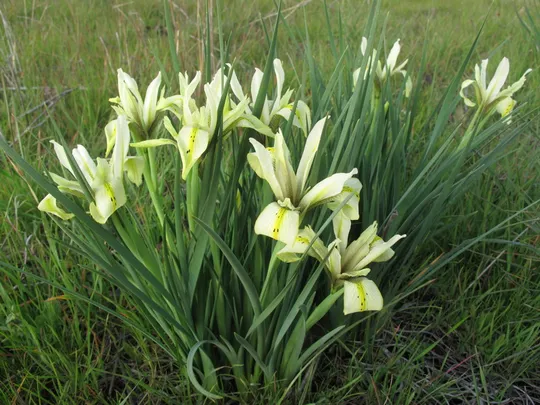
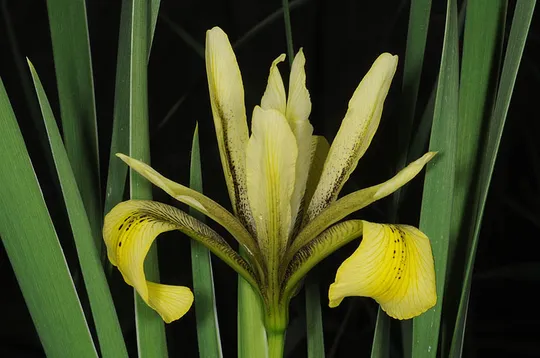
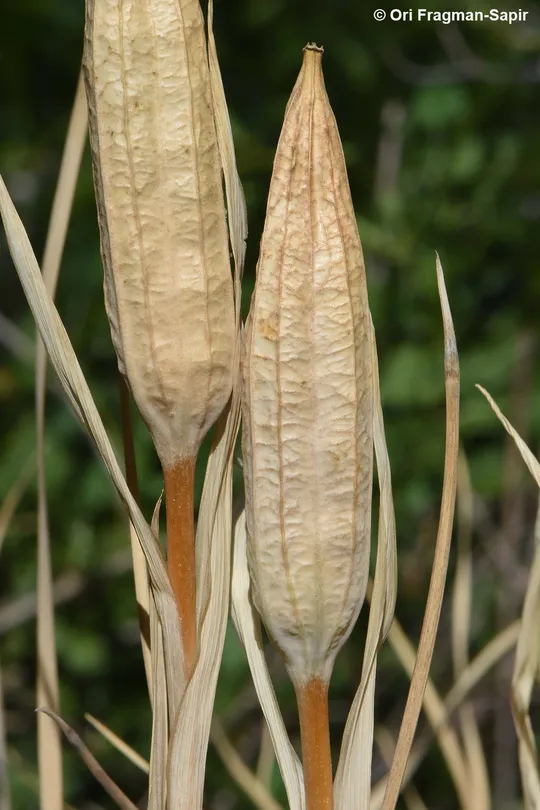
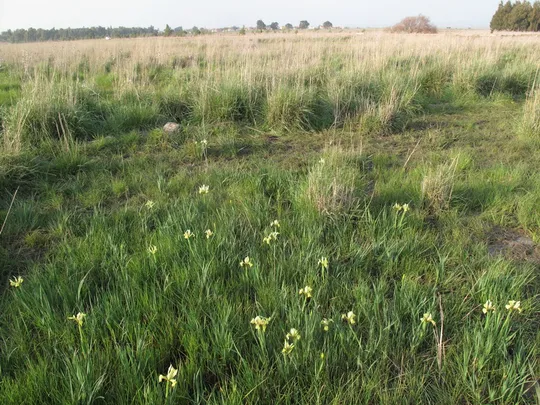
Iris grant-duffii is a geophyte whose rhizome branches out vegetatively creating clusters with several shoots, sometimes in dense stands. Its height is 30-60 cm. Each shoot has 4-7 slightly twisted linear leaves, 3-5 cm. wide that are taller than the flowers. A single flowering stem develops from each shoot with a pale yellow flower, 5-7 cm across. At the base of the outer perianth segments, there is a delicate, dense, regular striping, and their outspread front section is marked with a number of large, irregular spots/stripes. The inner perianth segments are erect and lanced. The lanced-elongated fruit opens gradually along valves during the summer. Seeds are round and dark, 2-4 mm across. I. grant-duffii flowers in early spring: populations at low altitudes, in the Jezreel Valley and the coastal plain, bloom at the end of February, while populations at higher altitudes, in the lower Galilee and the southern Golan, bloom from early March until March 20th.
The species grows in northern Israel and the Sharon, where its populations are shrinking because of drainage and water diversion. It was known formerly from a few water bodies in the Sharon, but today its presence is limited to the Zeta Swamp and Alexander Stream. On the Carmel coast, it disappeared from the Taninim Stream region. In Ramot Menashe, it is extinct in the Kibbutz Dalya region.
In the southern Golan, a large population thrives at the Nov Grant-Duff's Iris Reserve. Additional concentrations are found in the area surrounding the reserve. A few small populations exist in the Jezreel Valley and lower Galilee. It has almost completelydisappeared from the Acre Valley. Extinction is particularly extensive in the Haifa suburbs and Kishon regions. Flora Palaestina data regarding its existence on Mount Carmel, in Samaria and the upper Jordan Valley are questionable and have not been verified.
Deep, muddy soil that is flooded in the winter and dries in the summer. The species was common in most of the valleys in northern Israel in large stands in depressions that are flooded in the winter. Today, after these habitats have been drained and converted into agricultural fields, it survives primarily at the edges of fields in places which are still flooded in the winter. Altitude range: 30-400 m.
Iris grant-duffii belongs to the section Limniris, whose distribution ranges throughout the Northern Hemisphere. Within this section, it belongs to the Syriacae sub-section, common in southwestern Asia, mainly in southern Turkey, northern Iraq, Syria and Israel. These species are adapted to temporary winter pools. They dominate large areas of northern Syrian and Turkish marshes. The species of the Syrian sub-section are characterized by a strong rhizome with rigid thorns and swollen leave bases that look like bulbs. Five related species have been defined in this sub-section, but there is little information about them. It has been suggested that they be united into one diverse species with a broad distribution. Ofer Cohen found a clear pattern dividing the five species into two groups: yellow-flowered populations common in the west – closer to the Mediterranean Sea coast in southern Turkey, western Syria and Israel, which he suggested naming Iris grant-duffii; and purple-flowered populations common in the eastern region – far from the Mediterranean Sea (southern Turkey, northern Syria and northern Iraq), named I. masia.
• Drainage of marshes and their conversion to agriculture leads to habitat loss. Pesticides pose a great threat, because the species disappears immediately after spraying.
• The populations are limited to swampy habitats in fragmented sites separated from each other by a few to dozens of kilometers. The pattern at each location is of patches and colonies 0.25 sq. m. to a few meters across, a few meters apart.
• The number of individuals in Israel’s populations is estimated at between 100,000 to 1,000,000 shoots. In some of the locations in the Jezreel Valley, a declining trend in the number of patches and shoots has been observed over the past few years.
• This is a common plant in European water bodies and is not globally endangered.
• Protected in Israel at the Nov Grant-Duff's Iris Reserve in the Golan, where the largest population in the world of this species grows, as well as in the En Afek Reserve, where the plants were introduced by the Nature and Parks Authority
Declaration of the Tishbi Junction marshes, the edges of the National Water Carrier in the Beit Netofa Valley and the concentration next to Sde Ilan as nature reserves. Pesticides should not be sprayed in their vicinity. At the same time, they should be grown in botanical gardens and seed banks of the various populations should be established. The species should be naturalizes in swampy areas at rehabilitation sites in the Alexander and Taninim streams.
Middle East: southern Turkey, western and southern Syria and northern Israel.
Iris grant-duffii is endangered in Israel because its habitat (deep, flooded land) is rare, limited and in demand for development. The populations west of the Jordan have become extinct or very limited since the 1940s and only 30 populations survive today of several hundred that existed in the past. The situation is particularly severe in the Acre Valley and the Sharon; in these regions, the species is almost entirely extinct due to accelerated development.
כהן, ע. 1987. צמחים נדירים בארץ, אירוס הביצות. רתם 23–24: 127–135.
Current Occupancy Map
| 1000 squre meter pixel | 5000 squre meter pixel | 10000 squre meter pixel | |
|---|---|---|---|
| number of observations | 0 | 0 | 0 |
| in total pixels | 0 | 0 | 0 |
| Family | Iridaceae |
| Classification | On the endangered species list |
| Ecosystem | Mediterranean humid |
| Chorotype | Mediterranean |
| Conservation Site | En Afek Nature Reserve and Hula Nature Reserve |
| Rarity |
1
2
6
|
|---|---|
| Vulnerability |
0
4
4
|
| Attractiveness |
0
3
4
|
| Endemism |
0
2
4
|
| Red number |
1
6.3
10
|
| Peripherality | N |
| IUCN category | DD EW EX LC CR EN VU NT |
| Threat Definition according to the red book | Critically endangered |
 Based on:
Based on:
